Dogs and cats like to chew on things. That fact won’t come as a shock to any pet parent. Unfortunately, they also like to swallow some of those foreign items on which they nibble. This week I spend some time discussing how to help your fur baby should you find yourself in a scenario where your pet feasted from an inappropriate buffet. Happy reading!

GI Foreign Objects: What are they?
Pets eats many things they probably shouldn’t. Luckily most of the time these objects pass through the gastrointestinal (GI) tract with little or no complications. The problems arise when the ingested foreign item(s) gets stuck. Some of the more commonly ingested objects are:
- Children’s toys
- String/yarn
- Leashes
- Clothing (e.g.: socks, undergarments)
- Trash
- Coins
Many factors influence whether or not a pet experiences complications secondary to ingesting a foreign object. Some materials are toxic (e.g.: objects made of lead and zinc) and can cause secondary issues. Similarly, some items can cut through the intestines, necessitating emergency surgical intervention.
GI Foreign Objects: When should I be concerned?
Occasionally it’s obvious when a fur baby has ingested something inappropriate. You find the evidence. You see something unexpected in feces. More often, however, pet parents have no overt clue their pet did something naughty. As mentioned earlier, the clinical signs associated with gastrointestinal foreign objects vary depending on several factors, particularly:
- Location of foreign object
- Duration of time the foreign object has been in the gastrointestinal tract
- Severity of obstruction
- Composition of the foreign material
Common clinical signs include loss of appetite, vomiting, gagging, lethargy, and diarrhea. Pet parents may observe restlessness that is often indicative of abdominal discomfort. String foreign objects may be seen wrapped around the base of the tongue or protruding from the rectum.
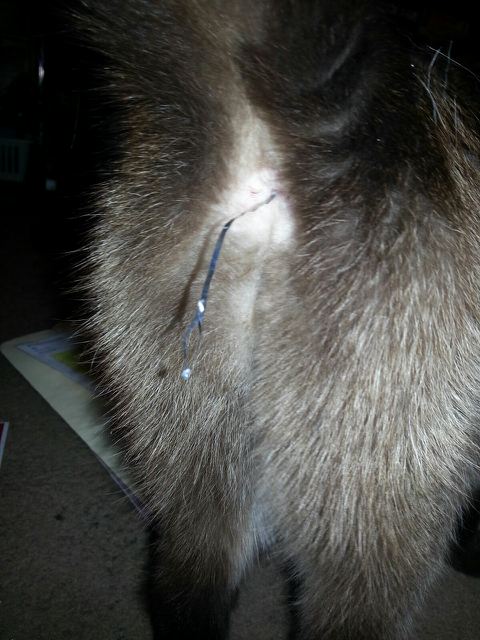
Don’t pull on the string! Rather seek immediate veterinary medical attention for your pet!
GI Foreign Objects: How are they diagnosed?
After obtaining a thorough patient history and performing a complete physical examination, a veterinarian will likely recommend some additional tests to identify and confirm the presence of a foreign object in your pet’s gastrointestinal tract. Screening blood and urine tests help identify and rule out various causes of a pet’s clinical signs. Diagnostic imaging, particularly radiographs/x-rays, are frequently extraordinarily helpful.
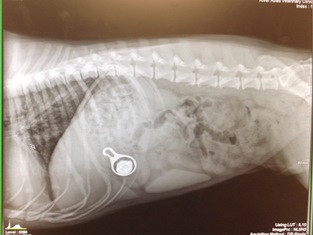
Not all foreign objects show up readily on radiographs (x-rays). Thus occasionally veterinarians will have pets drink/lick a special dye or paste (e.g.: barium) that highlights the gastrointestinal tract to show evidence of an ingested foreign object. This is called an “upper GI series” or “positive contrast GI study.”
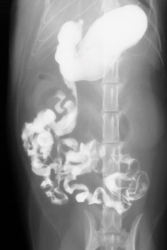
Ultrasonography is also a potentially useful tool for identifying foreign objects in the stomach and intestines. Performing ultrasonography is a unique skill, one that board-certified veterinary radiologists and board-certified veterinary internal medicine specialists learn during their respective residencies. The value of this experience simply can’t be underscored! While any veterinarian can purchase ultrasound equipment, the ability to perform accurate and diagnostic sonographic examinations comes from specialized training and extensive experience.
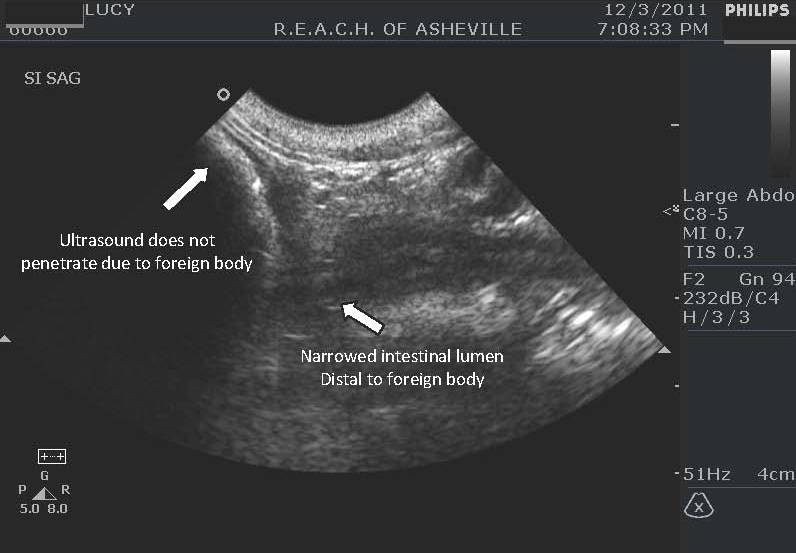
GI Foreign Objects: How are they removed?
The method by which foreign objects in the gastrointestinal tract are removed depends chiefly on the location of the foreign object, characteristics of the item (e.g.: size, sharp objects), and concurrent medical conditions of the patient. Certainly many foreign items have to be removed surgically. A veterinarian may have to make an incision into the stomach (called a gastrotomy) and/or the small intestines (called an enterotomy). Luckily most patients are able to defecate objects that are able to pass successfully into the colon (aka: large intestine).
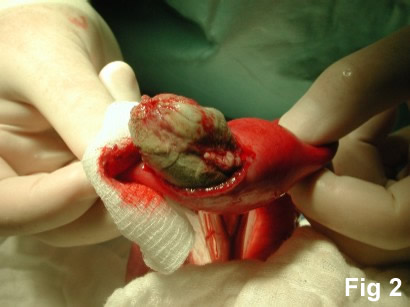
If the foreign item has caused extensive damage to a segment of the intestinal tract, the veterinarian will need to remove that section (called resection and anastomosis). Many primary care veterinarians are comfortable performing some gastrointestinal surgeries; however, you may be referred to a board-certified veterinary surgeon to help ensure the best possible outcome for your fur baby.
Some objects in the back of the mouth, esophagus, and stomach can be removed using a special flexible fiber-optic camera with unique graspers. This procedure is called endoscopy. It does not require a veterinarian to make an incision, and thus is much less invasive than surgery. However foreign items that have sharp edges and/or are caustic (e.g.: ruptured batteries) should not be removed via endoscopy because extraction may cause further serious damage. In the video below you can watch a veterinarian perform endoscopy to remove a foreign object from a dog’s stomach.
Endoscopy is a unique procedure that requires a great deal of training and experience to perform safely and properly. Board-certified veterinary internal medicine specialists and board-certified veterinary emergency and critical care specialists receive such training during their respective residencies. A primary care veterinarian may be comfortable performing this procedure, but you may be referred to a board-certified veterinary specialist who has more experience performing endoscopy.
The take-away about GI foreign objects…
Dogs and cats often like to eat things they really shouldn’t. If these objects get stuck in the gastrointestinal tract, they can cause serious and potentially life-threatening problems. Depending on a variety of factors, the object may simply pass through the stomach and intestines to be successfully defecated or it may need to be removed either via surgery or with a minimally invasive procedure called endoscopy. Your primary care veterinarian is well-equipped to initially help your fur baby, and partnering with a board-certified veterinary specialist may ultimately be necessary for a successful outcome.
To find a board-certified veterinary internal medicine specialist, please visit the American College of Veterinary Internal Medicine.
To find a board-certified veterinary emergency and critical care specialist, please visit the American College of Veterinary Emergency and Critical Care.
To find a board-certified veterinary surgeon, please visit the American College of Veterinary Surgeons.
Wishing you wet-nosed kisses,
cgb




